
“Scientists at the Department of Energy’s SLAC National Accelerator Laboratory and Stanford University have discovered a potential way to make graphene – a single layer of carbon atoms with great promise for future electronics – superconducting, a state in which it would carry electricity with 100 percent efficiency. Researchers used a beam of intense ultraviolet light to look deep into the electronic structure of a material made of alternating layers of graphene and calcium. While it’s been known for nearly a decade that this combined material is superconducting, the new study offers the first compelling evidence that the graphene layers are instrumental in this process, a discovery that could transform the engineering of materials for nanoscale electronic devices.”
